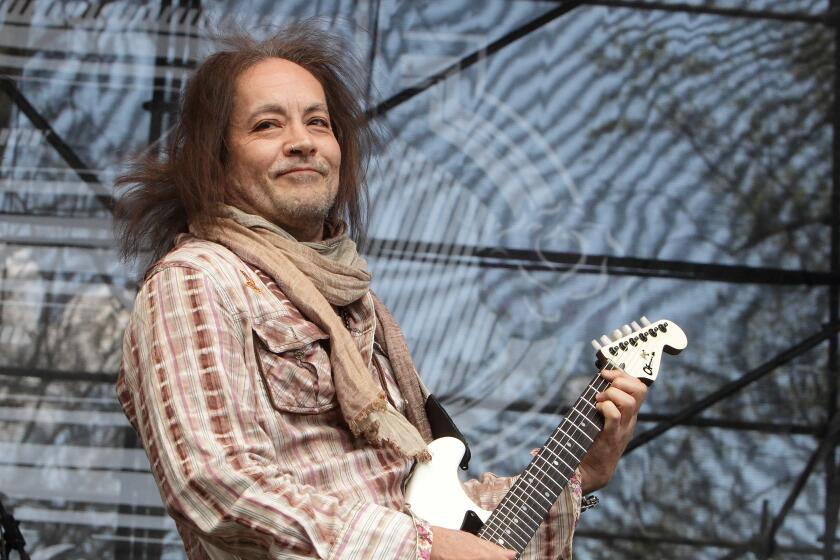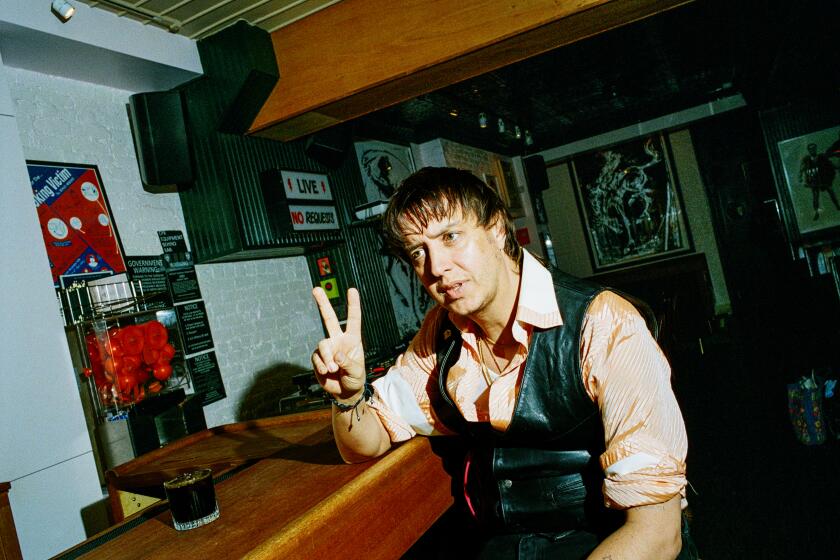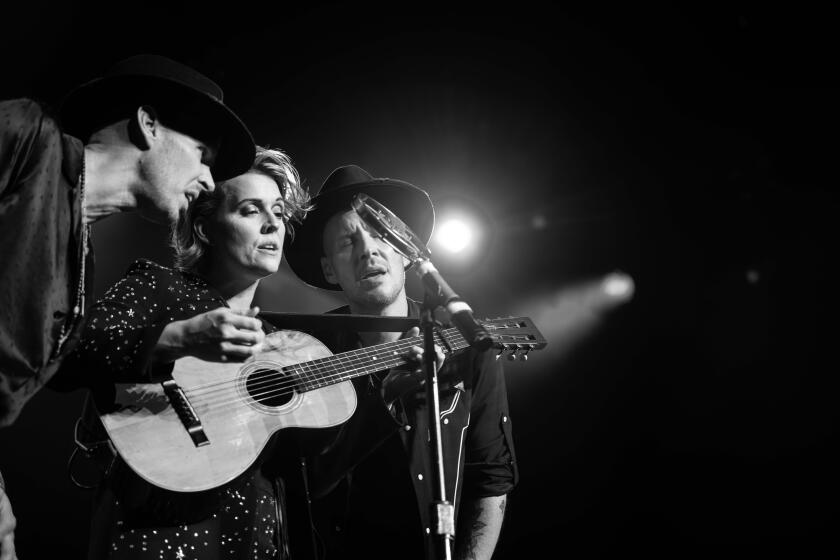MUSIC REVIEW : Cries, Whomps and Whimpers at the Ojai Finale
The brave, desperately with-it, stubbornly progressive festival in the little al-fresco amphitheater ended on Sunday with something big, loud and easy by this year’s music director, John Adams: the “Grand Pianola Music” of 1982.
The large audience of partisans assembled on the benches and grass responded with a lot of instant whooping and hollering. The specific ecstasy was reinforced, no doubt, with a general sense of relief, not to mention release.
Ojai had made it to the final whomping, throbbing, thumping, zonking, crashing cadence--call it a climax, if you must--without a raindrop falling on a single attentive head.
There had been some pesky precipitation, even here in what easily passes for Shangri-La. But any irregularities in the weather materialized between--not during--the seven demanding concerts crammed into a period of 2 1/2 delirious days.
*
Robert Bryan, a crusty chronicler of the local parade, attributed the cooperation of the elements to intervention by a friendly Chumash medicine man. Others suggested that no one, in any realm, would dare discommode Joan Kemper, the tireless and formidable president of the Ojai board.
In any case, the good guys won. Once again, Ojai was a happy weekend haven for those who like a little musical adventure along with their Ravel, Debussy and Copland.
This year, however, the quality of the adventure was uneven, to say the least. The artistic--as opposed to fiscal--success of Ojai ’93 had to be a matter of taste.
Make no mistake. Anyone who finds maximal pleasure in minimal challenges must have been happy, happy, happy, happy, happy, happy, happy. . . .
Anyone eager to sit back and enjoy a series of trendy, wildly unchallenging, unabashedly sensual rides must have found Libbey Bowl a very appealing amusement park.
Still, a few recalcitrant fossils--this one, for instance--pined for the distant days when musical menus weren’t dominated by junk food.
Sunday began blissfully enough, at 11, with Paul Crossley exploring the gentle graces of Debussy’s Book-I preludes. The sun shone, the birds sang, the pianist performed with enlightened fervor within a context of sensitive restraint. Even the microphones were miraculously cooperative.
After intermission, the reshuffled program turned to thornier fare--music of Toru Takemitsu and the ubiquitous Adams--as a prelude to Ravel’s “Miroirs.”
At mid-day, the action moved uphill, to the intimate Lamb Auditorium at Thacher School. Here, the focus of attention, and of pushbutton adoration, was the late John Cage.
No one can deny the wit, the vitality, the originality and the liberating curiosity of this rugged, all-American composer-inventor-iconoclast-philosopher-writer-fungologist. Some experts, however, might debate Adams’ contention that he was a seminal influence on contemporary composition.
The festival “garland” for Cage entailed an appropriately random sampling of songs interspersed with an appropriately random sampling of piano pieces. One person’s gimmickry, it must be remembered, is another’s poetry.
Joan La Barbara, a devoted prima donna assoluta in this rarefied repertory, demonstrated a wide range of breathy tones, a vast array of unconventional techniques, a few funny voices and lots of ingenious sound effects in constant quest of esoteric truth. It would be unfair as well as impolite to call her a hog-coloratura.
For her part, Gloria Cheng banged, tapped, rippled and tickled the properly prepared piano--and sometimes just the piano lid--always with virtuosic zeal and admirable, unflappable concentration. Much of the music gurgled sweetly.
The valedictory exercises brought the devout back to Libbey Bowl at 5:30. Adams, an efficient if not inspiring conductor, led a slightly rusty-sounding Los Angeles Chamber Orchestra through some jazzy period pieces en route to the Big Event.
First came Copland’s jazzy Music for the Theatre, pleasantly naive stuff written in 1925. It still amuses.
Then came Ravel’s jazzy Piano Concerto of 1931, engagingly piquant in the outer movements, an indulgence teetering on the brink of banal gush in the long-lined adagio. Capping an extraordinarily arduous day, Crossley dispatched the solo duties with equal parts elegance and eloquence.
Then came the “Grand Pianola.”
Pow.
Adams isn’t the cheeky primitive today that he was when he wrote this thing a decade ago. The Chamber Symphony, heard on Saturday, proves that.
Still, this endlessly bumping, grinding and churning, grimly pulsating, lushly ticking extravaganza bears numerous previews of coming Adams attractions. There’s a hint here of the Hollywood catharsis in “Harmonielehre,” a trace there of the beloved “Pig-pig-pig” chorus in “Nixon in China.”
The slush pump reaches its zenith of electrified vulgarity, complete with a smashing keyboard competition and the benediction of a wordless heavenly chorus, when Adams suddenly invents the wheel. That the composer knew what he was doing is reflected in his program annotation:
“What resulted was a swaying rocking oscillation of phrases that gave birth to a melody. By this point . . . I had encountered so many strange artifacts along the way that the appearance of a tune didn’t seem out of the ordinary.”
The not-so-grand “Pianola,” overdressed to a fault, sounds familiar even when it isn’t. That must be the curse, and the blessing, too, of minimalist madness.
Adams, in any case, writes bad music very well. He must be the Andrew Lloyd Webber of classical modernism.
More to Read
The biggest entertainment stories
Get our big stories about Hollywood, film, television, music, arts, culture and more right in your inbox as soon as they publish.
You may occasionally receive promotional content from the Los Angeles Times.










